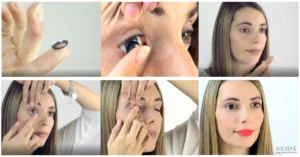The Evolution of Vision Correction | Origin Of Contact Lenses
To appreciate the significance of contact lenses, it’s important to understand the rich history of vision correction methods that preceded them. Over the years, humans have sought ways to improve their vision, leading to the development of various techniques and devices. This section explores the brief history of vision correction methods and the origin of contact lenses as a groundbreaking innovation.
A Brief History of Vision Correction Methods
Throughout history, people have employed numerous methods to correct vision impairments. From the ancient Egyptians using ground glass beads as early magnification devices to the first recorded use of spectacles in 13th-century Italy, vision correction has come a long way.
The invention of spectacles revolutionized vision correction by providing a simple and effective means to improve eyesight. Early spectacles consisted of convex or concave lenses made from glass, which were held in front of the eyes using frames. This breakthrough allowed individuals with nearsightedness, farsightedness, and astigmatism to experience clearer vision.
The Emergence of Contact Lenses
While spectacles were a significant advancement in vision correction, they were not without limitations. These limitations gave rise to the need for a more practical and versatile solution, leading to the emergence of contact lenses.
The idea of contact lenses dates back to the late 19th century when various inventors and scientists began exploring the concept of placing a lens directly on the cornea. Early attempts at contact lenses involved large and rigid glass lenses that covered the entire eye surface. However, these designs were uncomfortable and posed risks to eye health.
The breakthrough in contact lens technology came in the late 1940s with the introduction of glass contact lenses that were smaller and more comfortable to wear. These lenses were made from a type of glass called PMMA (polymethyl methacrylate) and covered only the cornea, allowing for improved vision correction and better compatibility with the eye.
The advent of glass contact lenses paved the way for future advancements in contact lens design, leading to the development of more comfortable and convenient options. The subsequent introduction of plastic contact lenses marked a significant milestone, as they were lighter, more flexible, and less prone to shattering than their glass counterparts.
As contact lens technology continued to evolve, manufacturers focused on shaping contact lenses for both comfort and vision. This led to the creation of specialized designs that catered to different vision needs, such as toric lenses for astigmatism and multifocal lenses for presbyopia. For more information on these types of lenses, visit our article on what are multifocal contact lenses?.
The evolution of vision correction methods ultimately led to the development of modern contact lenses, which offer a convenient and effective alternative to traditional spectacles. From the early attempts at contact lens design to the introduction of soft contact lenses, the journey of contact lenses has been one of continuous innovation and improvement.
By understanding the historical context and progression of vision correction methods, we can truly appreciate the significant impact that contact lenses have had on the lives of those who rely on them for clear and comfortable vision.
Pioneering Innovations
The history of contact lenses is marked by remarkable innovations that have revolutionized vision correction. Let’s explore the early attempts at contact lenses and the breakthrough that led to the development of glass contact lenses.
Early Attempts at Contact Lenses
The idea of using a lens to correct vision dates back centuries. However, it wasn’t until the 19th century that significant progress was made in the development of contact lenses. In 1887, Adolf Fick, a German ophthalmologist, designed and fitted the first successful contact lens made from blown glass. This lens, although uncomfortable and impractical for long-term wear, laid the foundation for future advancements in contact lens technology.
The Breakthrough: Glass Contact Lenses
The breakthrough in contact lens technology came in the early 20th century with the work of August Müller, a Swiss physician. In 1888, Müller developed a glass lens that could be directly applied to the eye. These lenses were larger and more comfortable to wear than their predecessors. By 1900, the first practical glass contact lenses were being manufactured and prescribed for individuals with various vision conditions.
Glass contact lenses were a significant improvement over earlier attempts. They were handmade and carefully fitted to match the curvature of the eye. However, they still posed limitations in terms of comfort and oxygen permeability. Despite these challenges, glass contact lenses paved the way for further advancements in contact lens design.
The pioneering innovations of early contact lens developers set the stage for subsequent breakthroughs in vision correction. The evolution of contact lenses continued with the introduction of plastic contact lenses. To learn more about the advancements in contact lens design and the introduction of plastic lenses, continue reading the section on Advancements in Contact Lens Design.
Advancements in Contact Lens Design
As the demand for contact lenses grew, advancements in technology led to the development of more comfortable and convenient options. This section explores two significant advancements in contact lens design: the introduction of plastic contact lenses and the focus on shaping contact lenses for comfort and vision.
Introduction of Plastic Contact Lenses
In the mid-20th century, a groundbreaking development occurred with the introduction of plastic contact lenses. These lenses replaced the earlier glass lenses, providing wearers with enhanced comfort and durability. The use of plastic materials, such as polymethyl methacrylate (PMMA), allowed for lighter and more flexible lenses.
Plastic contact lenses offered several advantages over their glass counterparts. They were less prone to breakage, making them safer and more suitable for everyday use. Additionally, the plastic material allowed oxygen to pass through to the cornea, promoting better eye health. This breakthrough in contact lens design paved the way for significant advancements in the field.
Shaping Contact Lenses for Comfort and Vision
Another important focus in contact lens design was shaping the lenses to improve both comfort and vision. Contact lenses needed to fit securely on the cornea while providing optimal visual correction. To achieve this, designers focused on two key elements: base curve and lens diameter.
The base curve refers to the curvature of the back surface of the contact lens. By customizing the base curve to match the natural curvature of the cornea, contact lenses could fit more comfortably and securely on the eye. This customization reduced the chances of lens movement and discomfort during wear.
The lens diameter, on the other hand, was adjusted to ensure proper coverage of the cornea. A well-fitted lens diameter allowed for optimal vision correction while minimizing the risk of irritation and discomfort.
Today, contact lenses are available in a wide range of base curves and lens diameters, catering to individual needs and preferences. It is essential to consult with an eye care professional to determine the most suitable contact lens parameters for your eyes.
Advancements in contact lens design, such as the introduction of plastic materials and the focus on shaping for comfort and vision, have significantly improved the experience of contact lens wearers. As technology continues to evolve, further enhancements are being made to ensure the comfort, safety, and visual acuity of contact lenses.
For more information on how to clean contact lenses properly, check out our article on how to clean contact lenses.
Modern Contact Lenses
As technology and innovation progressed, the field of contact lenses continued to evolve. In this section, we will explore the introduction of soft contact lenses and the further enhancements in contact lens technology that have transformed the way people correct their vision.
Introduction of Soft Contact Lenses
One of the most significant advancements in contact lens technology was the introduction of soft contact lenses. Unlike their predecessors, which were made of rigid materials, soft contact lenses are crafted from a flexible, water-containing plastic material called hydrogel.
Soft contact lenses revolutionized the world of vision correction by providing improved comfort and ease of use. The soft and flexible nature of these lenses allows them to conform to the shape of the eye, providing a comfortable fit and reducing the risk of discomfort or irritation. Additionally, the presence of water in the lens material helps to keep the eyes hydrated throughout the day.
Soft contact lenses quickly gained popularity among contact lens wearers due to their enhanced comfort and ease of handling. They are available in various types, including daily disposables, bi-weekly disposables, and monthly disposables, providing individuals with flexibility in terms of wear and replacement schedules.
Further Enhancements in Contact Lens Technology
Over time, contact lens technology continued to advance, leading to further enhancements in both design and materials. Some notable advancements include:
- Silicone Hydrogel Lenses: Silicone hydrogel lenses combine the benefits of soft contact lenses with increased oxygen permeability. These lenses allow more oxygen to reach the cornea, promoting better eye health and comfort.
- Multifocal Contact Lenses: Multifocal contact lenses are designed to address presbyopia, a condition that affects near vision in individuals over the age of 40. These lenses incorporate multiple prescription powers, allowing wearers to see clearly at different distances.
- Toric Contact Lenses: Toric contact lenses are specially designed to correct astigmatism, a common refractive error that results in blurred vision. These lenses have different powers in different meridians of the lens, ensuring clear and crisp vision for individuals with astigmatism.
- Daily Disposable Lenses: Daily disposable lenses offer the ultimate convenience and hygiene. They are designed to be worn once and discarded at the end of the day, eliminating the need for cleaning and storage. These lenses are ideal for individuals with active lifestyles or those prone to allergies.
With ongoing advancements in contact lens technology, wearers now have a wide range of options to suit their individual needs and preferences. However, it’s important to consult with an eye care professional to determine the best type of contact lenses for your specific vision requirements. They can assess your eye health, provide a prescription, and guide you in selecting the most suitable contact lenses for your needs.
As we continue to appreciate the evolution of contact lenses, it’s crucial to stay informed about proper care and maintenance. Visit our article on how to clean contact lenses to learn more about keeping your contact lenses clean and ensuring optimal eye health.
Conclusion
As we trace the history and evolution of contact lenses, it is truly fascinating to appreciate how far this vision correction method has come. From the early attempts and breakthroughs with glass contact lenses to the introduction of plastic contact lenses and the subsequent advancements in design and technology, contact lenses have undergone significant transformations.
The invention and development of contact lenses have revolutionized the lives of millions of people worldwide. Today, contact lenses offer a convenient and comfortable alternative to traditional eyeglasses. With the introduction of soft contact lenses and further enhancements in contact lens technology, wearers can enjoy improved comfort, better vision correction, and an array of options to suit their individual needs.
It is important for contact lens wearers to stay informed about proper care and usage to ensure the health and safety of their eyes. Topics such as how to remove contact lenses, how to clean contact lenses, and how to put in contact lenses are essential knowledge for anyone wearing contact lenses. For more detailed information and guidance on these topics, you can refer to our related articles on how to remove contact lenses?, how to clean contact lenses?, and how to put in contact lenses?.
The evolution of contact lenses is an ongoing process, with researchers and manufacturers continually striving to improve the comfort, safety, and effectiveness of these vision correction devices. If you have specific questions or concerns about contact lenses, it is always advisable to consult with your eye care professional, who can provide personalized advice and guidance based on your unique needs.
In conclusion, the invention of contact lenses has had a profound impact on the field of vision correction. From their humble beginnings to the modern advancements we see today, contact lenses have transformed the way people with refractive errors experience the world. As we move forward, it is exciting to anticipate the future developments that will further enhance the lives of contact lens wearers.

























